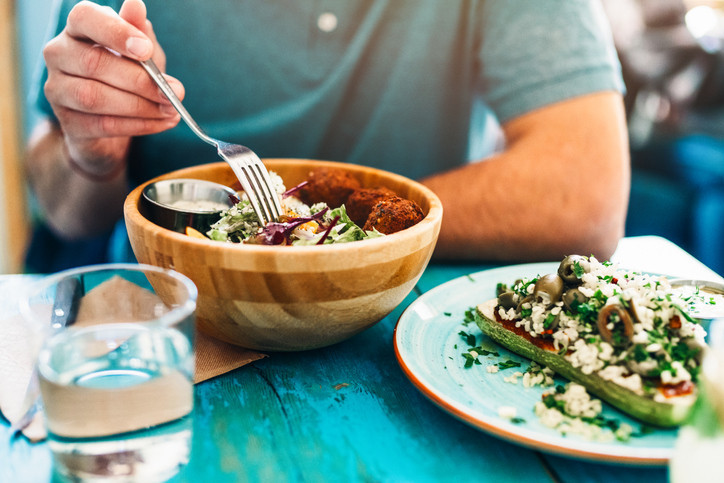
5 timeless habits for better health

What are the symptoms of prostate cancer?

Is your breakfast cereal healthy?

When pain signals an emergency: Symptoms you should never ignore

Does exercise give you energy?

Acupuncture for pain relief: How it works and what to expect

How to avoid jet lag: Tips for staying alert when you travel

Biofeedback therapy: How it works and how it can help relieve pain

Best vitamins and minerals for energy

Should you take probiotics with antibiotics?
Staying Healthy Archive
Articles
How can I protect myself from getting the common cold?
On call
Q. How does a cold virus spread from one person to the next? And what can I do to protect myself?
A. The common cold is most often spread by direct contact with the respiratory secretions of someone who is infected, typically through hand-to-hand contact. Here is how it happens: The person with a cold touches his or her mouth or nose (we do this all day without thinking). The cold viruses are now on the person's hands. The person then touches you, such as by shaking hands. You rub your eyes, nose, or mouth, and the viruses enter your body, and so it goes.
The act of balancing
Maintaining proper balance as you age requires attention, strength, and flexibility.
One skill that can sharply decline with age, and often with little warning, is your sense of balance.
"As people age, changes in flexibility, muscle strength and power, body sensation, reflexes, and even mental function all contribute to declining balance," says Dr. Brad Manor, associate director of the Mobility and Falls Translational Research Center with Harvard-affiliated Hebrew SeniorLife. "You need to work on all these factors to maintain a strong sense of balance."
Be ready for emergencies
Here are 10 ways to safeguard your life (and health) when an emergency or disaster strikes.
Natural disasters and other kinds of emergencies can strike anywhere and often with little warning. Yet, new data from the University of Michigan National Poll on Healthy Aging show that most adults ages 50 to 80 are ill-prepared for severe weather, long-term power outages, or other emergency situations.
"Older adults should take the time to focus on how they will cope and manage with an emergency," says Dr. Howard LeWine, assistant professor of medicine at Harvard Medical School and editor-in-chief of this newsletter. "A small effort now can protect their health and well-being when an emergency does occur."
Can supplements help boost your immune system?
Your money might be better spent on something else.
During the winter months, you've likely seen ads for products that claim to give your immune system a boost to help you ward off colds and the flu. But can something in a bottle, whether a vitamin formulation or probiotic, really rev up your immune system to help you stay healthy?
"Unfortunately, the reality is that those kinds of products aren't really offering you any benefit," says Michael Starnbach, a professor of microbiology at Harvard Medical School. "There's no evidence that they help in fighting disease."
4 ways to boost your energy naturally with breakfast
Healthful protein, slowly digested carbohydrates, fruit or vegetables serve up best morning mix
As you sleep, your body is hard at work digesting yesterday's dinner. By the time you wake up, your body and brain are demanding fresh fuel. "Breaking the fast" is a key way to power up in the morning. Do it right and the benefits can last all day.
If you miss the day's first meal, notes Dr. David S. Ludwig, a nutrition expert at Harvard-affiliated Children's Hospital Boston, you may start off with an energy deficit and have to tap into your energy reserves.
The physical benefits of yoga
Yoga promotes physical health in multiple different ways. Some of them derive from better stress management. Others come more directly from the physical movements and postures in yoga, which help promote flexibility and reduce joint pain.
Following are some of the physical benefits of yoga that have a growing body of research behind them. In addition to the conditions listed below, preliminary research also shows that yoga may help with migraines, osteoporosis, balance and mobility issues, multiple sclerosis, inflammatory bowel disease, fibromyalgia, and ADHD.
Restaurant survival strategies
Your best bet for meeting your health goals is to cook your own meals at home, where you can control the ingredients and portion sizes. However, we all enjoy eating out from time to time. Just keep in mind that restaurant meals—in particular, fast-food meals—are linked with higher intakes of calories, sugar, saturated fat, and sodium, and lower intakes of healthful foods, such as fruits, vegetables, and whole grains. One of the biggest problems you'll face when you dine out is sheer portion size, which has increased dramatically over the years. Those bigger portions translate into more calories, sodium, sugar, and saturated fat.
Fortunately, the dining scene has improved. The FDA now requires chain restaurants to provide consumers with clear and consistent nutrition information on menus, menu boards, and in writing, which can help you make healthier choices. And more and more restaurants are meeting consumers' desires for healthier fare by providing smaller portions, more fruits and vegetables on the menu, more vegetarian options, and lighter preparation styles.
Season of receiving: Use free services to stay independent
Nonprofit groups offer services that can help you age in place.
Image: © fstop123/Getty Images
The holidays are a time of giving, but they're also a time to put yourself on the receiving list and assess whether you should be taking advantage of free health-related services offered by nonprofit organizations. Services are widely available, often regardless of income. But you might not know they exist. "Most older adults aren't introduced to support services until they're hospitalized or they work with a case manager or social worker," explains Barbara Moscowitz, a geriatric social worker at Harvard-affiliated Massachusetts General Hospital. "You don't have to wait for such an event."
What's available
On the local level, you can often find free or low-cost dental clinics, emotional support groups, meal or grocery delivery services, transportation, in-home health evaluations, exercise classes, health education classes, home evaluations for fall prevention, companion programs, caregiver respite services, or programs to help you navigate difficult chronic health conditions and their treatment.
Bit by bit, Americans are eating healthier
News briefs
Americans are starting to eat a healthier diet, but we still have a long way to go, suggests a study (which included Harvard research) published Sept. 24, 2019, in JAMA. Researchers looked at health survey responses gathered from 1999 to 2016 from almost 44,000 American men and women. The good news: during the study, participants improved on the 100-point Healthy Eating Index, thanks to higher intakes of high-quality carbohydrates (such as whole grains), plant protein (such as whole grains and nuts), and unsaturated fats; and lower intakes of added sugars. The not-so-good news: 42% of the American diet is still coming from low-quality carbs, and about 12% is coming from saturated fat. Like turning a massive battleship, it takes time to change eating patterns. These findings confirm that a winning strategy includes swapping low-quality carbs for higher-quality ones, replacing some saturated fats (like those in red meat) with unsaturated fats (like those in nuts and fish), and reducing calories from carbs over all (fewer snacks and drinks with added sugars and refined grains). An outstanding and popular book to guide healthy eating is Eat, Drink and Be Healthy, by Walter Willett and P.J. Skerrett, from Harvard Health Publishing.
Image: Image Source/Getty Images
Is it safe to go vegan in older age?
The diet takes vegetarianism to the extreme and poses a risk for nutrient deficiency. But it does offer health benefits.
If tofu turkey and meatless meatloaf are on your holiday menu this year, you may have made the switch to a vegetarian diet, eliminating at least some animal protein. But how much animal protein can you safely cut out of your diet?
Vegetarian diet benefits
Among the many types of vegetarian diets, three are particularly common: a pescatarian diet allows seafood; a lacto-ovo diet allows dairy products and eggs; finally, a vegan diet allows no seafood, dairy, or other animal products.

5 timeless habits for better health

What are the symptoms of prostate cancer?

Is your breakfast cereal healthy?

When pain signals an emergency: Symptoms you should never ignore

Does exercise give you energy?

Acupuncture for pain relief: How it works and what to expect

How to avoid jet lag: Tips for staying alert when you travel

Biofeedback therapy: How it works and how it can help relieve pain

Best vitamins and minerals for energy

Should you take probiotics with antibiotics?
Free Healthbeat Signup
Get the latest in health news delivered to your inbox!
Sign Up











